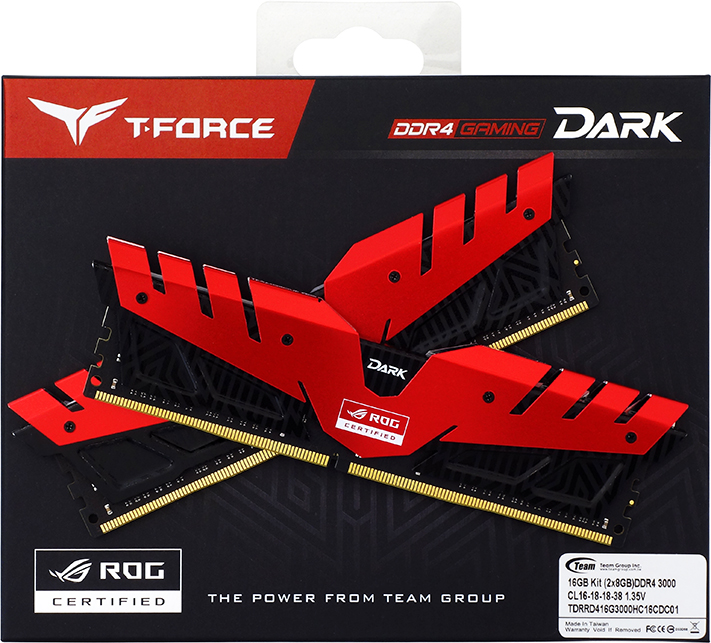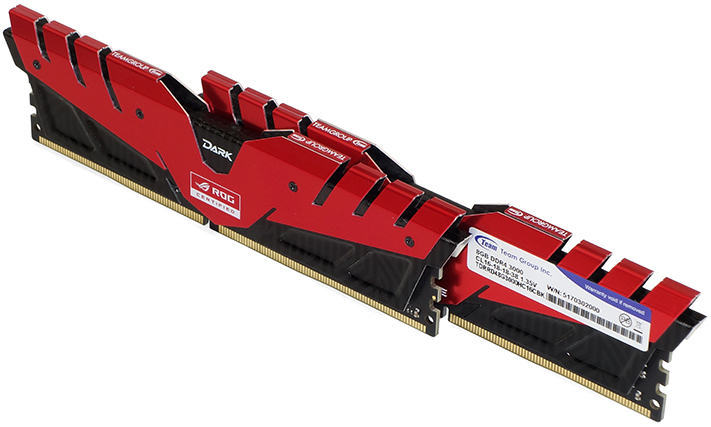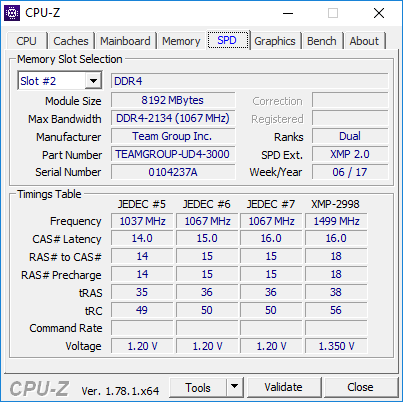Early Verdict
Team Group’s T-Force Dark ROG 16GB DDR4-3000 kit provides great performance value for LGA 1151 builders.
Pros
- +
Great XMP performance
- +
Excellent overclocked performance
- +
Reasonable price
Cons
- -
Mediocre rated timings
- -
Mediocre max O/C
- -
Mediocre latency
Why you can trust Tom's Hardware
Features & Specifications
Just as Asus has long used its ROG brand to market its top overclocking motherboards, Team Group (aka Teamgroup) has long used its T-Force brand to market improved specification RAM. It was only a matter of time before the two got together in a T-Force-ROG marketing bonanza, and today we get to test that pairing.
Note that we won’t be using the full name, Team Group T-Force Dark ROG DDR4, nor will we be using the full model number TDRRD416G3000HC16CDC01 outside of charts and tables. Many sellers don’t even use that ultra-long model number, instead removing the last two digits (TDRRD416G3000HC16CDC). Rest assured, your Google Product Search using the shorter number will take you to the correct parts!
Specifications
Four-piece heat spreaders are removable, revealing 16 Samsung ICs, which is an important number when paired with the fact that each side is addressed as a separate bank, making these dual-rank DIMMs: The word rank is used to prevent confusion between a bank of chips (on a module) and a bank of cells (within a chip). Rather than fill one side of the DIMM with eight 8Gb ICs to reach 8GB, Team Group equipped the T-Force Dark ROG with sixteen 4Gb chips.
We’ve noticed in the past that four single-sided modules outperformed two single-sided modules when paired with the memory controllers of Intel’s Kaby Lake and Skylake CPUs, and today we hope to show how the four-module performance advantage can be achieved using two dual-rank DIMMs. This information could be particularly useful to owners of Mini ITX systems, since those have only two slots.
The rest of the specs are basic, beginning with T-Force Dark ROG’s mediocre 16-18-18-38 timings at 1.35V while using its XMP-3000 rating. Prior to enabling a motherboard’s XMP setting, the motherboard will boot these modules at DDR4-2133 CAS 15 and 1.20V. We’re going to ignore any restrictions of the lifetime warranty and try to push these to more enviable settings.
MORE: Best Memory
MORE: DDR DRAM FAQs And Troubleshooting Guide
Get Tom's Hardware's best news and in-depth reviews, straight to your inbox.
MORE: All Memory Content
-
rhysiam Thanks for the review. Given the decent scaling we've seen from Ryzen CPUs with faster RAM, and Ryzen's somewhat unpredictable relationship with fast RAM kits, would Tom's HW consider a bit of Ryzen RAM Round Up? Throw a bunch of different RAM kits into a couple of Ryzen CPU + Mobo combinations to see how far you can get them while maintaining stability?Reply
I think plenty of people are on the lookout for reasonably priced kits which might get to 2933/3200Mhz (or even higher?) and a round up of a few kits you have on hand could be interesting and really helpful. -
Crashman Reply
TBH I don't even have any Ryzen hardware. The "Ryzen board" guy is considering doing an article, but he's backlogged with more board reviews. You'd be looking at another Ryzen deep-dive rather than a regular memory review, since I actually need Kaby Lake to get some of the faster memory sets up to full speed.19600650 said:Thanks for the review. Given the decent scaling we've seen from Ryzen CPUs with faster RAM, and Ryzen's somewhat unpredictable relationship with fast RAM kits, would Tom's HW consider a bit of Ryzen RAM Round Up? Throw a bunch of different RAM kits into a couple of Ryzen CPU + Mobo combinations to see how far you can get them while maintaining stability?
I think plenty of people are on the lookout for reasonably priced kits which might get to 2933/3200Mhz (or even higher?) and a round up of a few kits you have on hand could be interesting and really helpful.
-
winwiz I understand you need Kaby Lake to test the fast memory at full speed, but a Ryzen memory comparison would be so much more interestingReply
So please donate your Kaby Lake system to a second hand shop and get a Ryzen setup :-) -
bluzbrother I only half believe the excuses for DDR4 prices spiking, and supposedly will be on the ryze throughout 2017 into next year. I think Ryzen, especially the 5 series, is a big part of the prices shooting up. In this moment, I really don't see the value of these tests being done on an Intel platform... not to say there aren't people buying Intel, it's just that Ryzen is the more finicky platform right now, and people want the best for their money. (I definitely was not interested in paying $150+ for 16GB of RAM). I was very curious about this RAM, since it is one of the more reasonably priced brands.Reply



